
Back |
Ecuador:
Creating a station group |

Next |
|
|
| 1966.
Radio Musical's success included the overnight show, where
tropical dance music was played; the show was sold out at
daytime rates. This unusual condition for a post-midnight shift
was widely commented and I was worried that someone might "take"
the format fulltime on a competitor.
|
One of the
other 40 AMs, Radio Pacífico, on 805 kHz, had tried to
compete with the Radio Musical format. They lost all their money
in the attempt. Fausto Vallejo Silva, the owner, offered me
HCFV1 for $2,500 or S/. 50,000. I snapped it up, closed the
station and had the transmitter chucked down a ravine (this was
pre-environmental awareness).
A new station appeared in
its place... using the name of the overnight show, "Canal
Tropical." I decided to tune the new station into the
tower of the first. Below is the the ad published by the
consulting engineer and showing the diplexer and ATU for the
first such operation in all Ecuador. |
Canal Tropical
debuted on the 21st of May of 1966. It was pure cumbia, porro,
gaita, mapayé, with a bolero or two thrown in for flavor. High
energy jocks played the hits 24 hours a day on this tropical
station with Top 40 formatics. A 15-day ratings sweep was half
way through that Saturday, but HCFV managed to show
nonetheless... at #1 in middle and lower income listeners!
And
the station’s
working class appeal was a perfect complement to the upper
income youth appeal of its sister station.
The first
song on the air was Sonia López' "La Pollera Colorá" which was a
hit cumbia at the time. ,
click here.
|
|
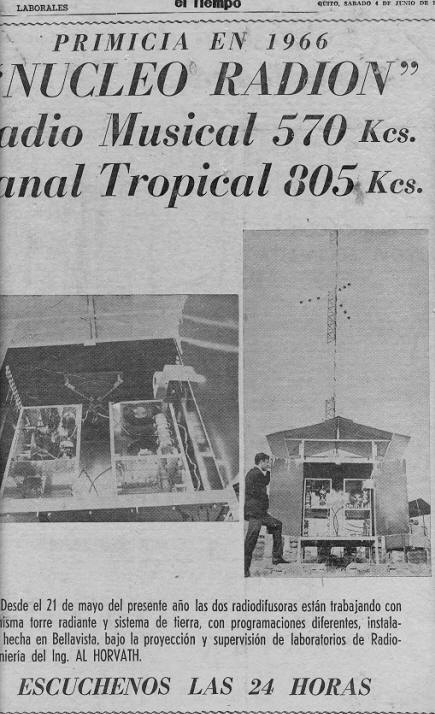 |
Canal Tropical, HCFV1
was diplexed into the same tower as Radio Musical
using a tuning and rejection unit designed by Ing Al
Horvath. |
|
|
The "owner's" office at 1027
Avenida Amazonas in Quito. Records were the
decorating motif as can be seen from the following
pictures, too |
 |
|
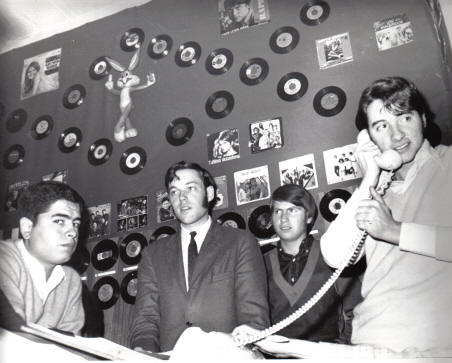 |
In
the Radio Musical Canal 57 studio (second from left)
with production manager Edwin Almeida (left) and "El
Pollo" Fuentes, Chile's top pop singer of the era.
Fuentes was taking listener calls as part of a
concert the station presented in Quito. |
|
| At the "board" (a Gates Yard) at Radio Musical. The
Fairchild reverb, the Yard power supply and a CBS
Audimax were in the rack. |
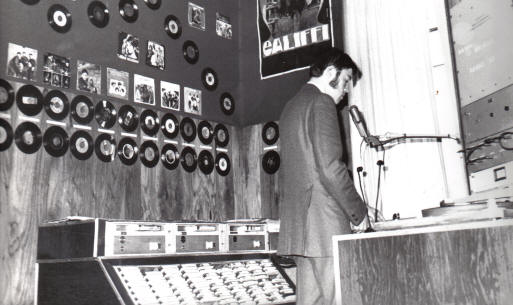 |
|
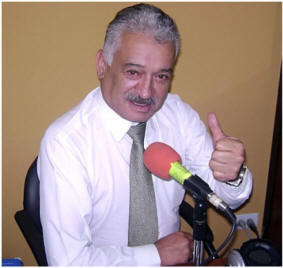 |
Patricio Toro, one of
the best announcers on Radio Musical and Canal
Tropical. Click on the photo for an interview (in
Spanish) with Patricio where he describes how he was
hired by me. Part of that interview appears below:
|
|
"Later... I received
several phone calls from a gringo who spoke horrible
Spanish that I could not understand, who invited me
to visit a station he had just built and which had
the the absolute best technology that existed at the
time, and which had recruited the best announcers of
the time and I thought he was playing a joke on me
and I never paid any attention until I got a call
from Guillermo Jácome, one of the the best voices
ever and he said that Mr. David Gleason, a US
citizen, had called me and he requested that I come
for an interview to the facilities of |
the station that would
become Canal Tropical AM. I went and
they offered me a salary that was ten times greater than what I
was making plus all the required benefits, and later it became
the leading radio group in the country, Núcleo Radión, made up
of Radio Musical, Canal Tropical, Radio Fiesta on AM and
Teleonda Musical on FM, the first commercial FM (in Ecuador) At
Canal Tropical, I spent a wonderful era in my career and was
also the official voice of the Núcleo Radión and of Teleonda FM.
" |
|
Growth
What do you do when you are sold out for two years, besides
raise rates every few months? You buy or build new stations.
This ad was from an advertisers guide published in 1967. There
were now four stations, including one very special one:
Ecuador's... and Northern South America's very first independent
FM station. |
1967.
At this time, Quito had only one TV station and no independent
FM facilities. A license was requested for the country’s first
commercial independent FM. Going on the air at midyear, easy
listening HCTM1 maintained a stance of "no commercials" for 6
months.
In fact, I had not intended to sell advertising
on the station ever; it was a tribute to my first job in radio
at an FM. But at lunch with a client, the distributor of
Ecuador's only instant coffee, I was asked to have my
salesperson drop by for a contract on the FM. When I mentioned I
did not sell ads on the FM, I was asked to name a rate... I
simply multiplied my highest AM rate by four to discourage the
deal. Surprisingly, he said yes... so I said, "the spots are
only 20 seconds" and was told this was fine. |
The appeal of
the format among advertisers became so high that "Teleonda"
achieved sellout within its first year. The format was a hybrid
of beautiful music and the traditional folk and national music
of Latin America. Three song sets would include two
instrumentals, and a vocal which might have been a tango, a
vals, a pasillo or a bambuco as well as trios and folksongs.
Total commercial time in each hour was two minutes, in six
twenty-second spots.
A year later, Teleonda became the
first stereo station in the country and moved its transmitter to
a small mountaintop overlooking the city. We went stereo by
modifying a test bench stereo generator intended for radio
repair shops and injecting it into our home made exciter. It lit
the pilot light on radios and had true stereo separation! |
|
| As can be seen from
the ratings from a few years later (graphic of Datos, S.A. table above on this page),
Teleonda was #2 in upper income listenership, and in the top 10 in
middle income audience. The station was always sold out... and this
was before 1970! FM had arrived and was successful in Ecuador before
the average FM in the US or Mexico was! |
|
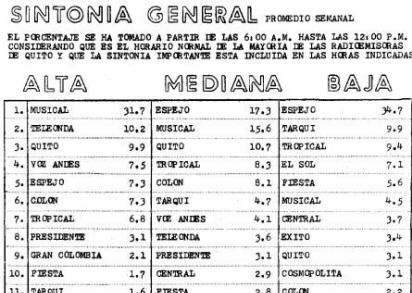 |
A "6
AM-Midnight" summary form a 1969 Datos, S.A. survey of Quito. In
upper income levels, my stations were #1, #2, #7 and #10 and
accounted for nearly 50% of listening. In middle income, 4 of
the top 11 were mine, and three stations had 20% of the lower
income audience. Click on the partial table for the whole page
of these 1970 ratings.
Interestingly, the #2
station in 1969 in upper income was an independent FM, Teleonda.
This station was the first independent FM in northern South
America and was profitable in its first year on the air. |
|
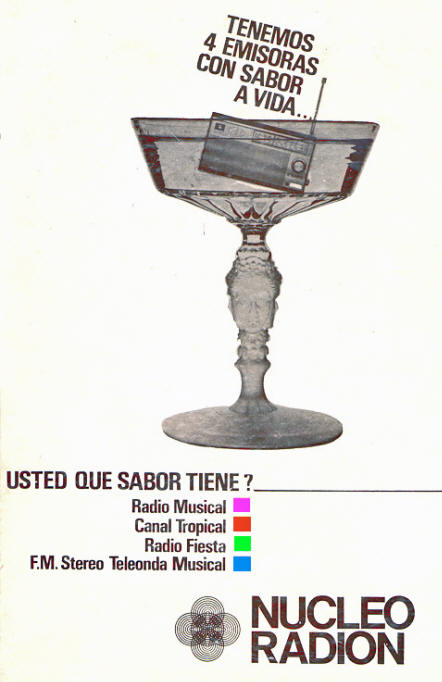 |
Thia ad appeared in an
advertising trade publication emphasizing the
variety of formats on the Núcleo Radión Quito
stations
"We have 4 stations with the taste of life.
And what flavor do you have?" |
|
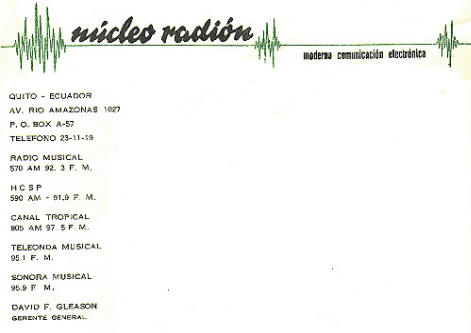 |
| Letterhead and cards for the group a few years later. Note that
there were FM simulcasts on each of the 3 AM stations, and two
independent FMs for a total of 8 stations in Quito alone. |
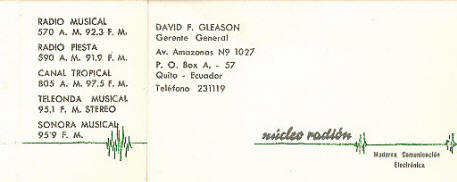 |
|
1967. Our only
failure. Next to Radio Musical's 570 frequency there
was a rural station, some 60 kilometers outside of
Quito, at San Pedro de Amaguaña in the same province
of Pichincha. It was HCSP1, at 595 kHz. Recognizing
that the station could fit into the Quito dial, I
bought it via an intermediary and moved it to Quito
and had it reassigned to 590. A transmitter site was
built right off the Panamericana Sur, about 4 km
south of the Villaflora, in nice wet land. The
stations signal covered parts of 6 provinces.
I wanted to create the Ecuadorian equivalent of
Mexico City's Radio Centro, a nostalgia format with
boleros and trios and romantic crooners. The
playlist was extensive, as opposed to the Top 40
style of my other stations. It was called La Voz
Amiga.
Nobody listened.
|
Nobody. I
learned a lesson about playlist length, at some
cost. I also learned the art of the move-in, taking
a rural station and moving it to the big city. Of
course, nobody called it a "move in" yet!
But in 1968, I changed programming.
The one music format
was still missing: Ecuadorian folk music, the music
of the indigenous population. Another station had
shot up in ratings with the format, so 590 AM became Radio
Fiesta, and immediately made a profit. And quashed
the competitor, too. Although the
listener target was not much sought by advertisers,
there was considerable profit to be made in messages
for rural areas and greetings in general. Sold at a
premium, each stopset consisted of many "meet me at
the bus from Quito" and "your mother had her
operation in the city and is fine" announcements. |
|
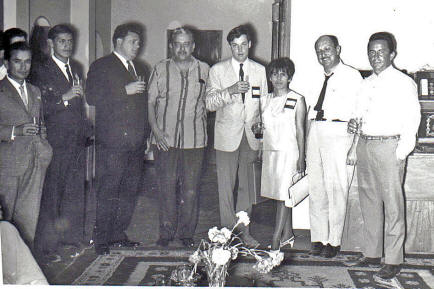 |
The 1967 Asociación Ecuatoriana de
Radiodifusión met in Guayaquil for its annual assembly. Here is
the opening reception picture with a number of other station
owners. |
|
|
One of the meetings at the 1967 AER general assembly. Front row, far
left is Guillermo Jácome, operations manager of the Núcleo Radión
group. |
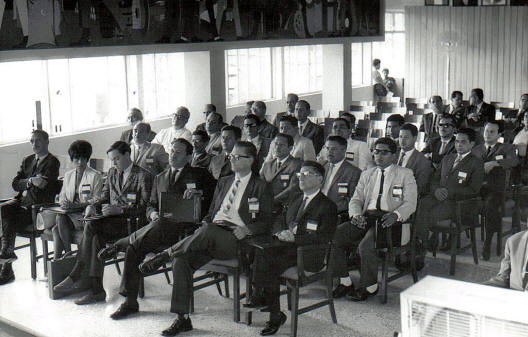 |
| |
|
|
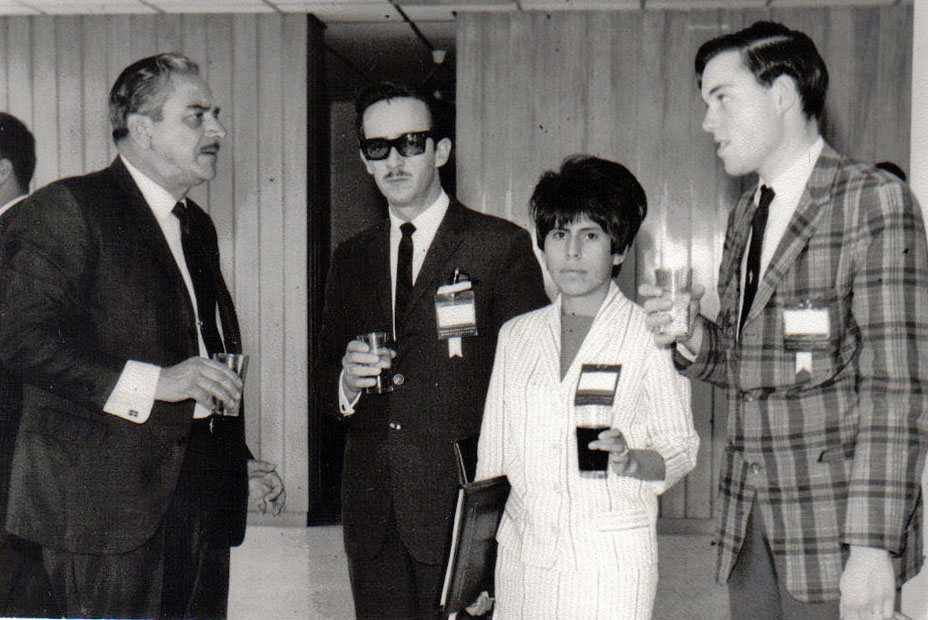 |
In 1968,
the Interamerican Asociation of Broadcasters held its convention
in Quito. I was asked by Arch Madsen, the US delegate, to assist
in the organizing of the event. Here is a surviving snapshot of
the opening night reception. To the left is Rafael Guerrero
Valenzuela, owner of CRE and Tropicana in Guayaquil. The
location is the Hotel Quito Intercontinental in the capital.
|
|
1969.
Another FM license was requested,
and HCTT1 signed on in 1968 with a mix of paid embassy
programming and classical music. Within a year, a weekend rock
program had proven itself so successful that the station became
the first contemporary FM in South America, playing the latest
Stones, Beatles and Zeppelin cuts.
During this same year,
the original three Quito AM stations installed simulcast
transmitters on FM. The 5 stations in Quito accounted for nearly
half of all radio audience in the market. During the period
between 1964 and 1969, I was sole owner, manager, group
programmer and sales manager, as well as chief engineer.
Such multi-functioned owner-operator descriptions were common.
One owner in Quito, Numa Pompilio Castro of Radio Cosmopolita,
also did his station's morning show where he would identify
himself as "Numa Pompilio Castro, dueño, propietario, locutor y
portero" or "Owner, operator, announcer and janitor."
|
With the
announcement of the discovery of petroleum in the Orient to the
East of the Andes and the construction of a pipeline, I applied
for and was granted AM stations in Lago Agrio (in the jungle)
and Bahía de Caraquez (at the pipeline's end on the Pacific. I
also built a mini-Musical in Ambato on 1480 and licensed but
never built Radio Musical 840 AM in Tulcán.
1970.
The economic situation in Ecuador looked to be rapidly
deteriorating, with runaway inflation, currency controls and
shortages of everything. For 6 months, I lived in Washington,
D.C. while preparing for the F.C.C. First Class Radiotelephone
operator’s license. At the same time, joined EZ Communications
as operations manager for WEZR in suburban Fairfax, Virginia as
well as assisting in the transition of the company’s WEZS in
Richmond from classical music programming to Beautiful Music.
Additionally, I did market research and community ascertainment
for an application to construct a new Class B FM in the Norfolk,
Virginia area. |
| |
|
|
1970.
The economic situation in Ecuador looked to be rapidly
deteriorating, with runaway inflation, currency controls and
shortages of everything. For 6 months, I lived in Washington,
D.C. while preparing for the F.C.C. First Class Radiotelephone
operator’s license. At the same time, joined EZ Communications
as operations manager for WEZR in suburban Fairfax, Virginia as
well as assisting in the transition of the company’s WEZS in
Richmond from classical music programming to Beautiful Music.
Additionally, I did market research and community ascertainment
for an application to construct a new Class B FM in the Norfolk,
Virginia area.
The
objective of
this move to the U.S. was to establish a relationship with a
company that was rapidly expanding into FM broadcasting and in
which a substantial investment would be possible upon the sale
of stations in South America. |
 |
|
While in the Washington
DC area, I took the FCC First Class licence exam. |
|
1970.
Unable to immediately sell the stations, returned to Ecuador and
in partnership with the Bank of Guayaquil, built individual AM
stations in Cuenca, Quito and Guayaquil, the country’s top 3
markets. (My associate and partner in this venture, Attorney
Jaime Nebot Saadi, was the leading presidential candidate in the
1996 elections and is presently the Mayor of Guayaquil) The
Guayaquil station, using the Canal Tropical format from Quito,
quickly rose to #1 in the million plus market of Guayaquil.
Failure of Bank of Guayaquil
(closely associated with 1970’s losing political party, the
CFP), and dangerous political unrest forced a hasty emergency
departure from Ecuador, in late 1970. |
|
 |
 |
The Radio
Musical-sponsored Mini in the Ecuador cross country motor racing
event in 1967. Ing. Eduardo Cruz drove the car.
To the left, Ing. Cruz next to another of his vehicles which I
helped sponsor, the HCTT "Teleonda Musical" VW. HCTT1 was
Ecuador's and the Bolivarian nations' first FM station.
|
|
Finally, I want to mention all the
fine people who were
part of the
Núcleo Radión team from 1964 to 1970. |
Guillermo Jácome Jiménez
Jorge Endara
Pepe Rosenfeld
Gabriel Espinosa de los Monteros
Pedro Chassi
Roberto García
Ulpiano Orozco
Jorge Obando
Jorge Obando
Edwin Almeida Marañon (QEPD)
Lucho Castellanos
Fabricio Cifuentes
Patricio Toro
Vicente Córdova
Mary Lou Parra |
Fausto Vallejo
Patricio Moncayo
Ing.
Fred Simon (Telco)
Ing. Eduardo Cruz (QEPD)
Ing. Al Horvath
Alberto Rivadeneira
Byron Guerra
Matilde Lalama
Marco Díaz
Susana Játiva
Patricio Moncayo
... and many more.
(If underlined,
there is a link to more about this person) |
|
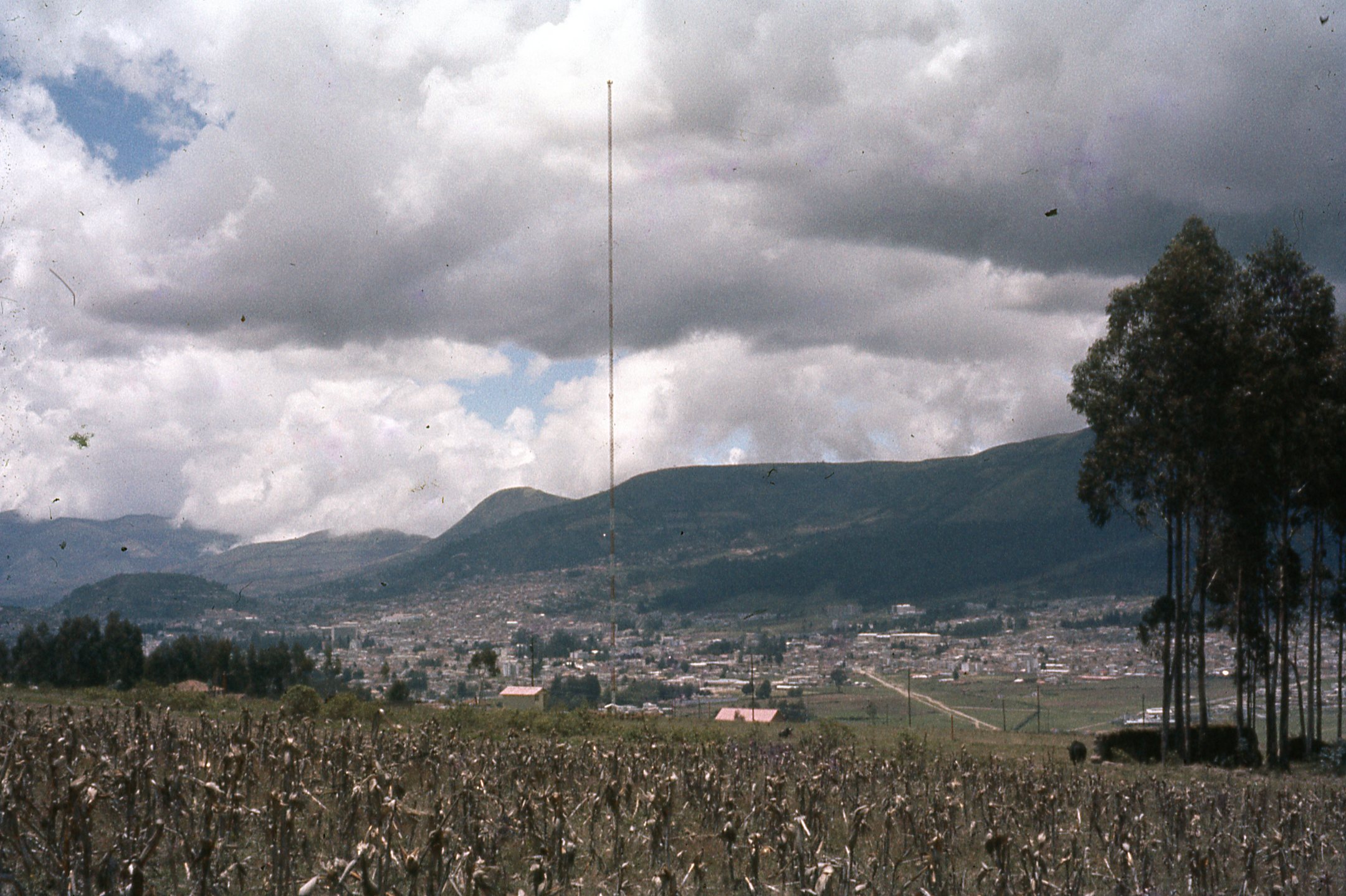 |
HCRM 1 transmitter
site in Bellavista overlooking Quito.
This station fell silent in
1996, 32 years after making radio history
as the first Top 40 station in all South America. |
|